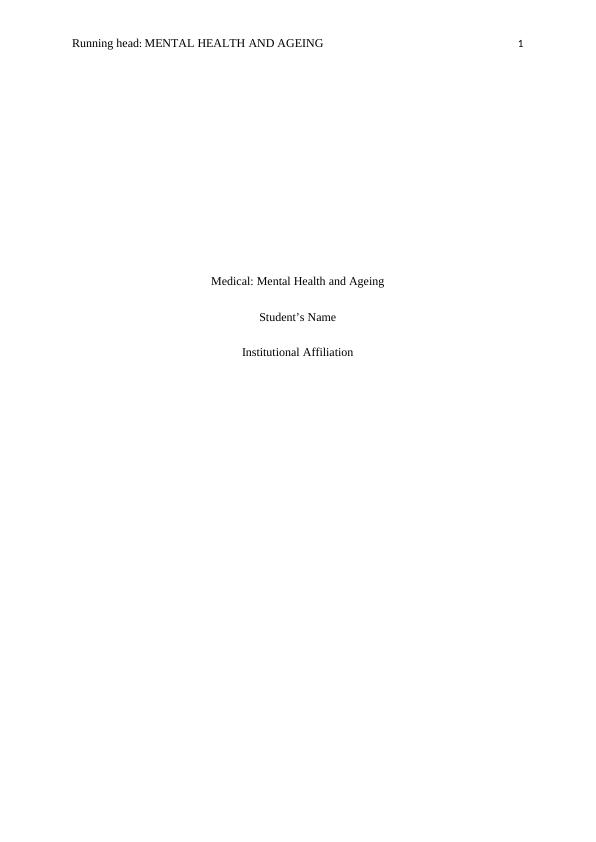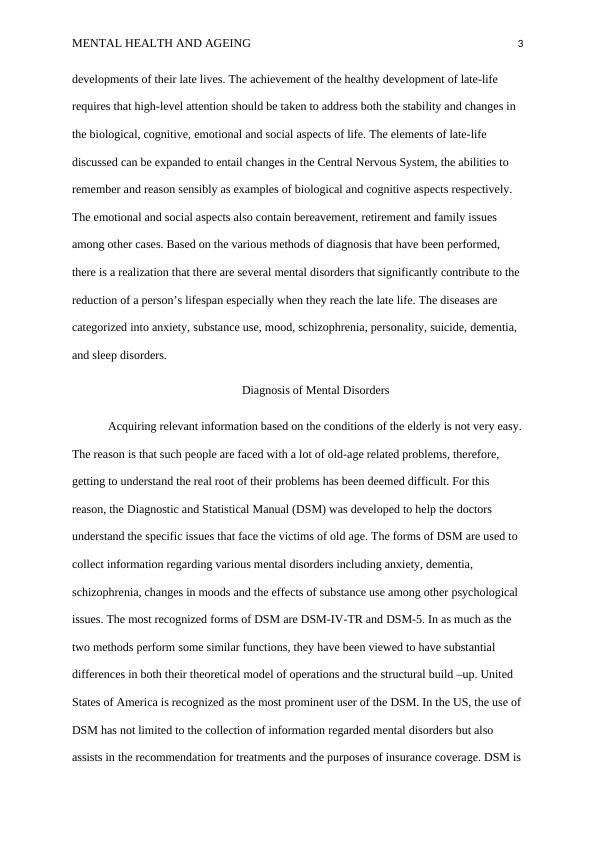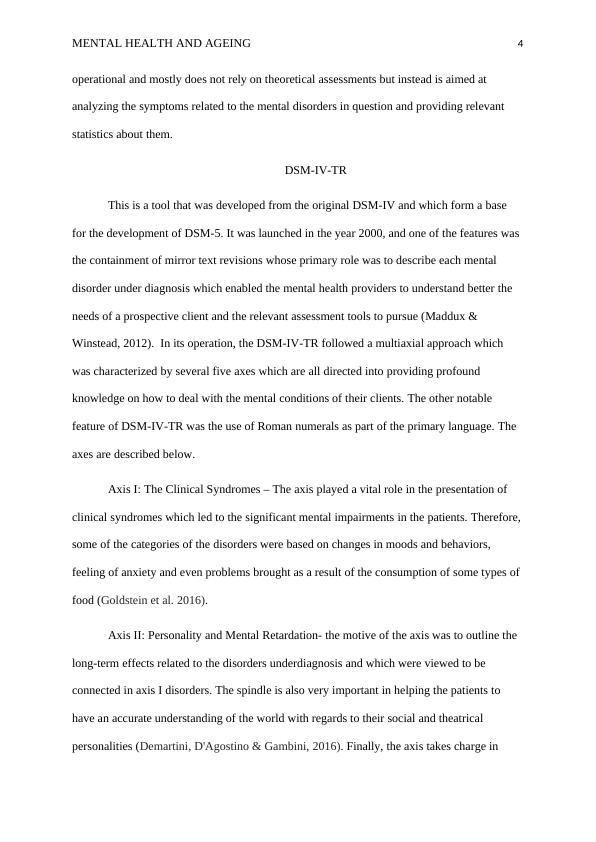Mental Health and Ageing
Added on 2023-02-01
17 Pages5198 Words24 Views
Running head: MENTAL HEALTH AND AGEING 1
Medical: Mental Health and Ageing
Student’s Name
Institutional Affiliation
Medical: Mental Health and Ageing
Student’s Name
Institutional Affiliation

MENTAL HEALTH AND AGEING 2
Introduction
Every human being needs to live a complete life. The completeness of human life
entails the pleasures and comforts arising from the lack of diseases, enough food, and
resources, peaceful coexistence with neighbors, mental and emotional stability among other
factors. However, to attain complete life requirements, there is a need to undertake the
psychopathological studies on a person’s health. The definition of Psychopathology is the
study of a person’s mental illnesses and the required classifications that would help come up
with the preferable methods to prevent and control the disorders and their effects (Steptoe,
Deaton & Stone, 2015). Under psychopathology, there are many other issues which need to
be addressed. The items include but not limited to making an effort to understand the
psychological, genetic, biological and social causes of mental disorders. It is based on the
issues presented that the performance on psychopathology would be regarded as successful.
The elderly in society may be vulnerable to several mental illnesses that may adversely affect
the quality of their lives (Arokiasamy et al. 2015). Therefore, it is equally essential for
physicians to diagnose and ascertain the causes of their ill-health and prescribe the most
appropriate treatment measures. With the increased need to collect statistical data of mental
disorders, there was the development of Diagnostic and Statistical Manual (DSM) for the
mental disorders.
The motive of this paper analyzes and give an understanding of the age-related mental
disorders and the possible differences that occur in the diagnosis of mental disorders via the
application of DSM-IV-TR and DSM-5. A proper and detailed analysis of both the
ideological and structural differences between the two methods of diagnosis are included.
Life in the old age is mostly regarded as late life, and it’s faced with several issues.
Several diagnostic processes are performed to ensure that the victims are exposed to standard
Introduction
Every human being needs to live a complete life. The completeness of human life
entails the pleasures and comforts arising from the lack of diseases, enough food, and
resources, peaceful coexistence with neighbors, mental and emotional stability among other
factors. However, to attain complete life requirements, there is a need to undertake the
psychopathological studies on a person’s health. The definition of Psychopathology is the
study of a person’s mental illnesses and the required classifications that would help come up
with the preferable methods to prevent and control the disorders and their effects (Steptoe,
Deaton & Stone, 2015). Under psychopathology, there are many other issues which need to
be addressed. The items include but not limited to making an effort to understand the
psychological, genetic, biological and social causes of mental disorders. It is based on the
issues presented that the performance on psychopathology would be regarded as successful.
The elderly in society may be vulnerable to several mental illnesses that may adversely affect
the quality of their lives (Arokiasamy et al. 2015). Therefore, it is equally essential for
physicians to diagnose and ascertain the causes of their ill-health and prescribe the most
appropriate treatment measures. With the increased need to collect statistical data of mental
disorders, there was the development of Diagnostic and Statistical Manual (DSM) for the
mental disorders.
The motive of this paper analyzes and give an understanding of the age-related mental
disorders and the possible differences that occur in the diagnosis of mental disorders via the
application of DSM-IV-TR and DSM-5. A proper and detailed analysis of both the
ideological and structural differences between the two methods of diagnosis are included.
Life in the old age is mostly regarded as late life, and it’s faced with several issues.
Several diagnostic processes are performed to ensure that the victims are exposed to standard

MENTAL HEALTH AND AGEING 3
developments of their late lives. The achievement of the healthy development of late-life
requires that high-level attention should be taken to address both the stability and changes in
the biological, cognitive, emotional and social aspects of life. The elements of late-life
discussed can be expanded to entail changes in the Central Nervous System, the abilities to
remember and reason sensibly as examples of biological and cognitive aspects respectively.
The emotional and social aspects also contain bereavement, retirement and family issues
among other cases. Based on the various methods of diagnosis that have been performed,
there is a realization that there are several mental disorders that significantly contribute to the
reduction of a person’s lifespan especially when they reach the late life. The diseases are
categorized into anxiety, substance use, mood, schizophrenia, personality, suicide, dementia,
and sleep disorders.
Diagnosis of Mental Disorders
Acquiring relevant information based on the conditions of the elderly is not very easy.
The reason is that such people are faced with a lot of old-age related problems, therefore,
getting to understand the real root of their problems has been deemed difficult. For this
reason, the Diagnostic and Statistical Manual (DSM) was developed to help the doctors
understand the specific issues that face the victims of old age. The forms of DSM are used to
collect information regarding various mental disorders including anxiety, dementia,
schizophrenia, changes in moods and the effects of substance use among other psychological
issues. The most recognized forms of DSM are DSM-IV-TR and DSM-5. In as much as the
two methods perform some similar functions, they have been viewed to have substantial
differences in both their theoretical model of operations and the structural build –up. United
States of America is recognized as the most prominent user of the DSM. In the US, the use of
DSM has not limited to the collection of information regarded mental disorders but also
assists in the recommendation for treatments and the purposes of insurance coverage. DSM is
developments of their late lives. The achievement of the healthy development of late-life
requires that high-level attention should be taken to address both the stability and changes in
the biological, cognitive, emotional and social aspects of life. The elements of late-life
discussed can be expanded to entail changes in the Central Nervous System, the abilities to
remember and reason sensibly as examples of biological and cognitive aspects respectively.
The emotional and social aspects also contain bereavement, retirement and family issues
among other cases. Based on the various methods of diagnosis that have been performed,
there is a realization that there are several mental disorders that significantly contribute to the
reduction of a person’s lifespan especially when they reach the late life. The diseases are
categorized into anxiety, substance use, mood, schizophrenia, personality, suicide, dementia,
and sleep disorders.
Diagnosis of Mental Disorders
Acquiring relevant information based on the conditions of the elderly is not very easy.
The reason is that such people are faced with a lot of old-age related problems, therefore,
getting to understand the real root of their problems has been deemed difficult. For this
reason, the Diagnostic and Statistical Manual (DSM) was developed to help the doctors
understand the specific issues that face the victims of old age. The forms of DSM are used to
collect information regarding various mental disorders including anxiety, dementia,
schizophrenia, changes in moods and the effects of substance use among other psychological
issues. The most recognized forms of DSM are DSM-IV-TR and DSM-5. In as much as the
two methods perform some similar functions, they have been viewed to have substantial
differences in both their theoretical model of operations and the structural build –up. United
States of America is recognized as the most prominent user of the DSM. In the US, the use of
DSM has not limited to the collection of information regarded mental disorders but also
assists in the recommendation for treatments and the purposes of insurance coverage. DSM is

MENTAL HEALTH AND AGEING 4
operational and mostly does not rely on theoretical assessments but instead is aimed at
analyzing the symptoms related to the mental disorders in question and providing relevant
statistics about them.
DSM-IV-TR
This is a tool that was developed from the original DSM-IV and which form a base
for the development of DSM-5. It was launched in the year 2000, and one of the features was
the containment of mirror text revisions whose primary role was to describe each mental
disorder under diagnosis which enabled the mental health providers to understand better the
needs of a prospective client and the relevant assessment tools to pursue (Maddux &
Winstead, 2012). In its operation, the DSM-IV-TR followed a multiaxial approach which
was characterized by several five axes which are all directed into providing profound
knowledge on how to deal with the mental conditions of their clients. The other notable
feature of DSM-IV-TR was the use of Roman numerals as part of the primary language. The
axes are described below.
Axis I: The Clinical Syndromes – The axis played a vital role in the presentation of
clinical syndromes which led to the significant mental impairments in the patients. Therefore,
some of the categories of the disorders were based on changes in moods and behaviors,
feeling of anxiety and even problems brought as a result of the consumption of some types of
food (Goldstein et al. 2016).
Axis II: Personality and Mental Retardation- the motive of the axis was to outline the
long-term effects related to the disorders underdiagnosis and which were viewed to be
connected in axis I disorders. The spindle is also very important in helping the patients to
have an accurate understanding of the world with regards to their social and theatrical
personalities (Demartini, D'Agostino & Gambini, 2016). Finally, the axis takes charge in
operational and mostly does not rely on theoretical assessments but instead is aimed at
analyzing the symptoms related to the mental disorders in question and providing relevant
statistics about them.
DSM-IV-TR
This is a tool that was developed from the original DSM-IV and which form a base
for the development of DSM-5. It was launched in the year 2000, and one of the features was
the containment of mirror text revisions whose primary role was to describe each mental
disorder under diagnosis which enabled the mental health providers to understand better the
needs of a prospective client and the relevant assessment tools to pursue (Maddux &
Winstead, 2012). In its operation, the DSM-IV-TR followed a multiaxial approach which
was characterized by several five axes which are all directed into providing profound
knowledge on how to deal with the mental conditions of their clients. The other notable
feature of DSM-IV-TR was the use of Roman numerals as part of the primary language. The
axes are described below.
Axis I: The Clinical Syndromes – The axis played a vital role in the presentation of
clinical syndromes which led to the significant mental impairments in the patients. Therefore,
some of the categories of the disorders were based on changes in moods and behaviors,
feeling of anxiety and even problems brought as a result of the consumption of some types of
food (Goldstein et al. 2016).
Axis II: Personality and Mental Retardation- the motive of the axis was to outline the
long-term effects related to the disorders underdiagnosis and which were viewed to be
connected in axis I disorders. The spindle is also very important in helping the patients to
have an accurate understanding of the world with regards to their social and theatrical
personalities (Demartini, D'Agostino & Gambini, 2016). Finally, the axis takes charge in

End of preview
Want to access all the pages? Upload your documents or become a member.
Related Documents
Psychological Disorder Assignment PDFlg...
|10
|3226
|252
Understanding Depression: Clinical Manifestation and Psychopathologylg...
|12
|3430
|498
Depression in Women: Risk Factors and Diagnosislg...
|10
|2641
|42
Psychiatric Diagnostic Categories and Its Impactlg...
|13
|3300
|40
Alcohol and Mental Health.lg...
|6
|1944
|2
Biopsychosocial Model of Abnormal Psychology Disorderlg...
|11
|2470
|35
